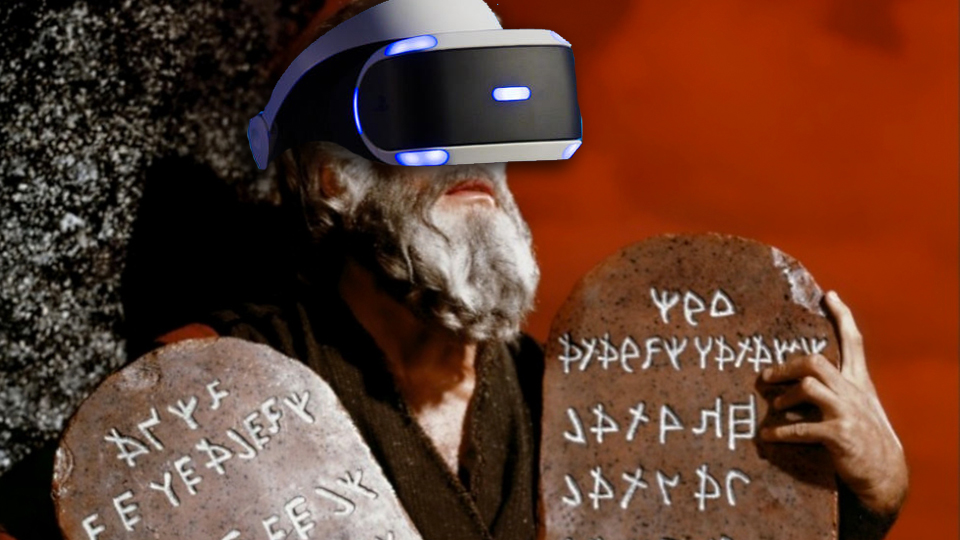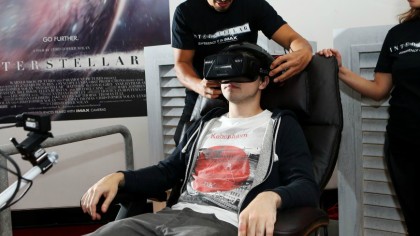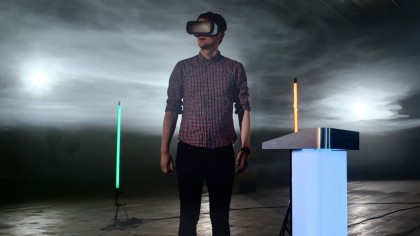
In the beginning, there was Pong. And while we've not yet reached the seventh day of videogame creativity, the coming of virtual reality headsets like PlayStation VR and Oculus Rift would probably sit somewhere around day five in the gaming equivalent of the Creation story.
But just because the tech is moving forward, not every developer is paying heed to what actually makes for a good VR experience.
Time to don a comedy beard and do our best Charlton Heston impressions: these are the 10 VR Commandments that need to be lived by.
1. Thou shall limit the bounds of player space
As much as it would be great to be able to run across the VR fields, frolic in the meadows and generally have a nice time in a big space, that's not possible for most people. We usually have a dingy, tiny living room that can't accurately host an entire meadow, unless that meadow is filled with sofas and dirty laundry.
Find a way to limit the player's movement just enough that some walking around is possible - to get a good angle on something we're looking at, for example - but try not to make it feel like a limit. Easier said than done, I know.
2. Thou shall recall that not every sense works
In VR, we can only see and sometimes hear the things around us. We can't feel anything, or smell anything, and though people might be working on the smelling part, the feeling part will always leave a game seeming slightly lacking - especially as our only input is the controller, and not our hands.
We'd love to reach out and touch the leaves, feel the heat of a fire, and take in the world in a more tactile way - but we can't, and there needs to be a reason for that. Maybe everything is deadly poisonous, maybe your hands are busy. There are always reasons.
Get daily insight, inspiration and deals in your inbox
Sign up for breaking news, reviews, opinion, top tech deals, and more.

3. If thine avatar sits, thou should also be sitting
There is something REALLY unnerving about playing a game standing up in real life, looking around, interacting with objects, then looking down and seeing that your legs are draped over a chair.
Your brain can't deal with that. You fall over. You feel silly. Likewise, sitting in real life and standing in the game is odd. More manageable, because it's hard to fall out of a chair, but you get this sense of weird vertigo like your brain is going "LEGS...BROKE? LEGS GONE BAD. SOMETHING IS BAD AND WRONG." Your brain, bless it, is only trying to help.
4. Thou shall establish trust with the player
One of the reasons VR freaks me out is that it's like being blindfolded. You don't know if someone behind you is making rude gestures, or if you look stupid even as you're immersed in a fantasy wonderland.
There could be a film crew documenting you crawling on the floor in the conference centre where the game is being demoed, and you'd never even know because you think you're looking for water in a VR desert.
So please: do whatever you can to reassure the person who's about to put on the headset that you are trustworthy and nice people, because no one likes being blindfolded.
5. Thy gloves are thy friends
You're never going to be able to make the player-character look or feel like every single person that puts on that VR headset. Sometimes they're too tall, too small, the wrong ethnicity, the wrong gender.
Sometimes that can be an exciting and eye-opening experience! But generally you'll want people to feel like their hands are their own, and I've seen a lot of VR games adopt gloves for this reason. It is pretty unsettling to look down and see hands that are so clearly not yours, but if they're in gloves, it's not as weird.
6. Thou shall cast out unworthy menus
You've created an incredible thing to look at! The vastness of space, or cool fantasy creatures, or a spooky horror game! So please don't fill it with lots of immersion-breaking interfacey stuff, because that makes us feel like we're just playing a game.
VR is about wonder and being transported to another world, so it's cool to have menus at the start, but if you're trying to simulate an actual human experience - unless it's all space-agey, Minority Report stuff - we don't really want to see big words popping up asking if we want to SAVE or QUIT.

7. Thine kingdom need not be be realistic
Unfortunately, realism doesn't work that well with VR. What you have to aim for is coherence and consistency - if you turn your head, the view should move, but if you need to walk forward, it doesn't have to be exactly like real life with head-bouncing and swaying from side to side as you take a step. That would just make everyone throw up.
The less perfect the VR experience is, the less the player will expect, and the easier it is to fool them into seeing everything as real.
8. But thine kingdom must be carefully built
Motion sickness is a very real issue with VR, and one of the main problems causing nausea is latency. If you turn your head and there is even the slightest amount of lag - even as much as a few milliseconds - you'll feel very, very queasy. Same goes for frame rates, which need to be high and consistent.
In short, the faster a VR game can run, the less people will throw up. Pretty important stuff.

9. Thou hast nice legs. Cast thine eyes upon them
There are quite a few games that don't give you legs. In non-VR first-person games, this is often the case - you look down, and there are no legs. Zero legs.
It's a bit weird in a non-VR game but it's even weirder in a VR game where you are actually inhabiting the body of the character. Maybe you're not supposed to look down, but of course you're going to. It's pretty complicated to animate legs from a first-person perspective, especially if you're also trying to map that to real-life movement, so it's easy to see why legs are often missed out, but still. Legs are nice.
10. Thou shall rest only when sound is also worthy
The level of immersion you can achieve with VR is dependent on many factors - visuals, obviously; not making people's brains freak out too much; and your use of sound.
Good use of stereo sound will create an auditory atmosphere with the illusion of depth and dimension, and gives the player another type of clue to where they're supposed to be heading - follow the voice, walk away from the scary dinosaur roar. Telling a story with sound as well as visuals is an excellent way of creating a realistic world.